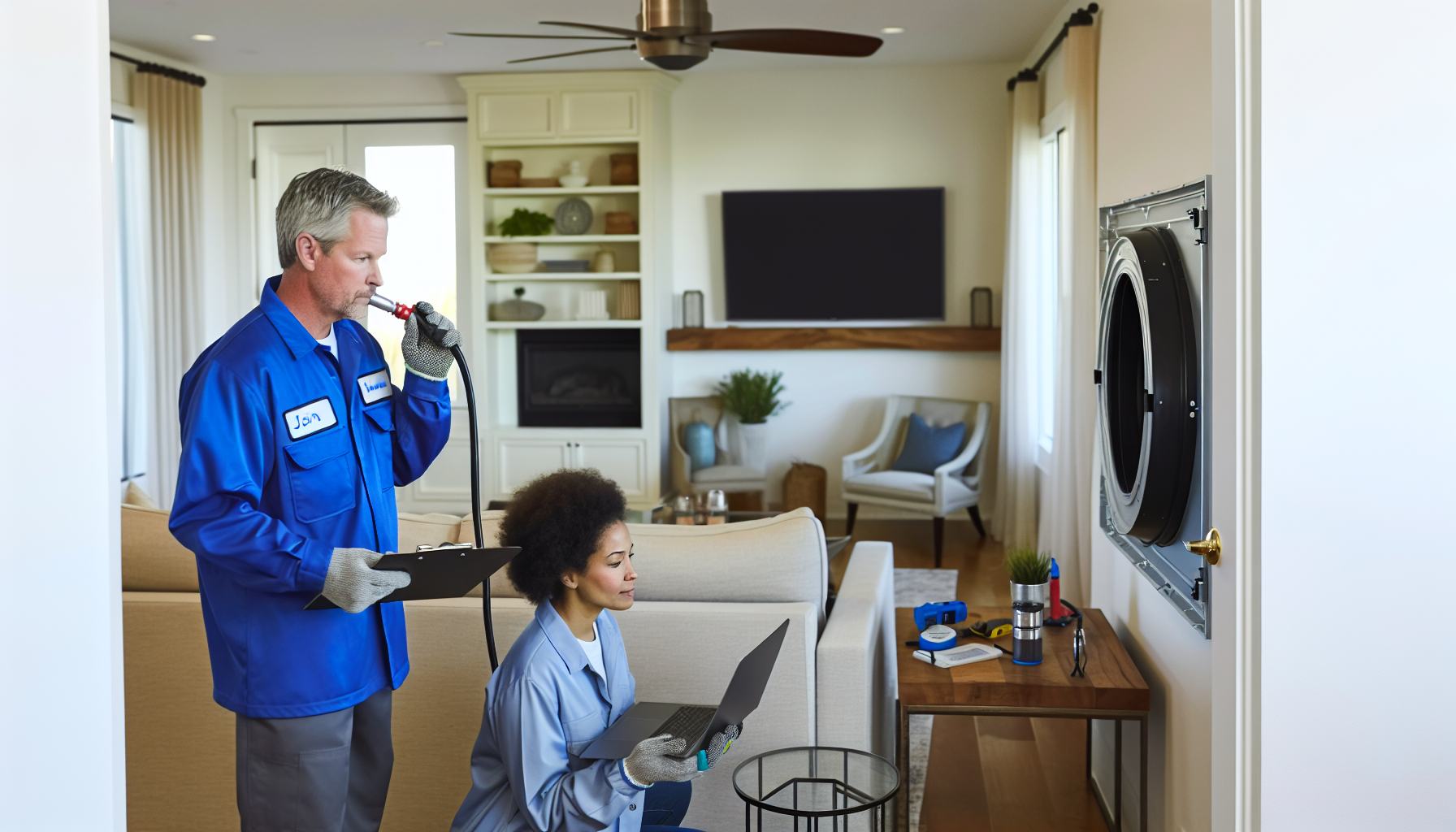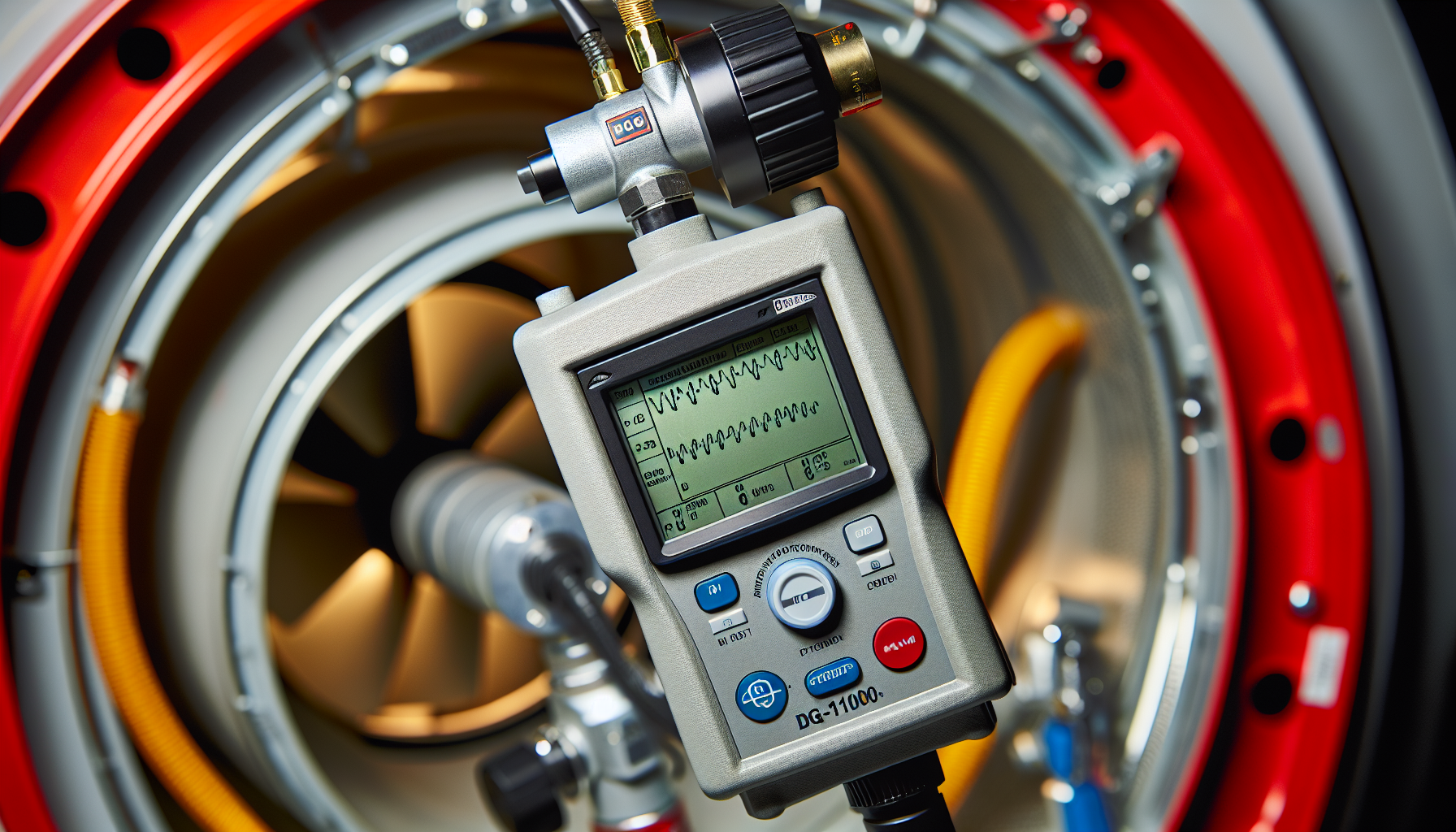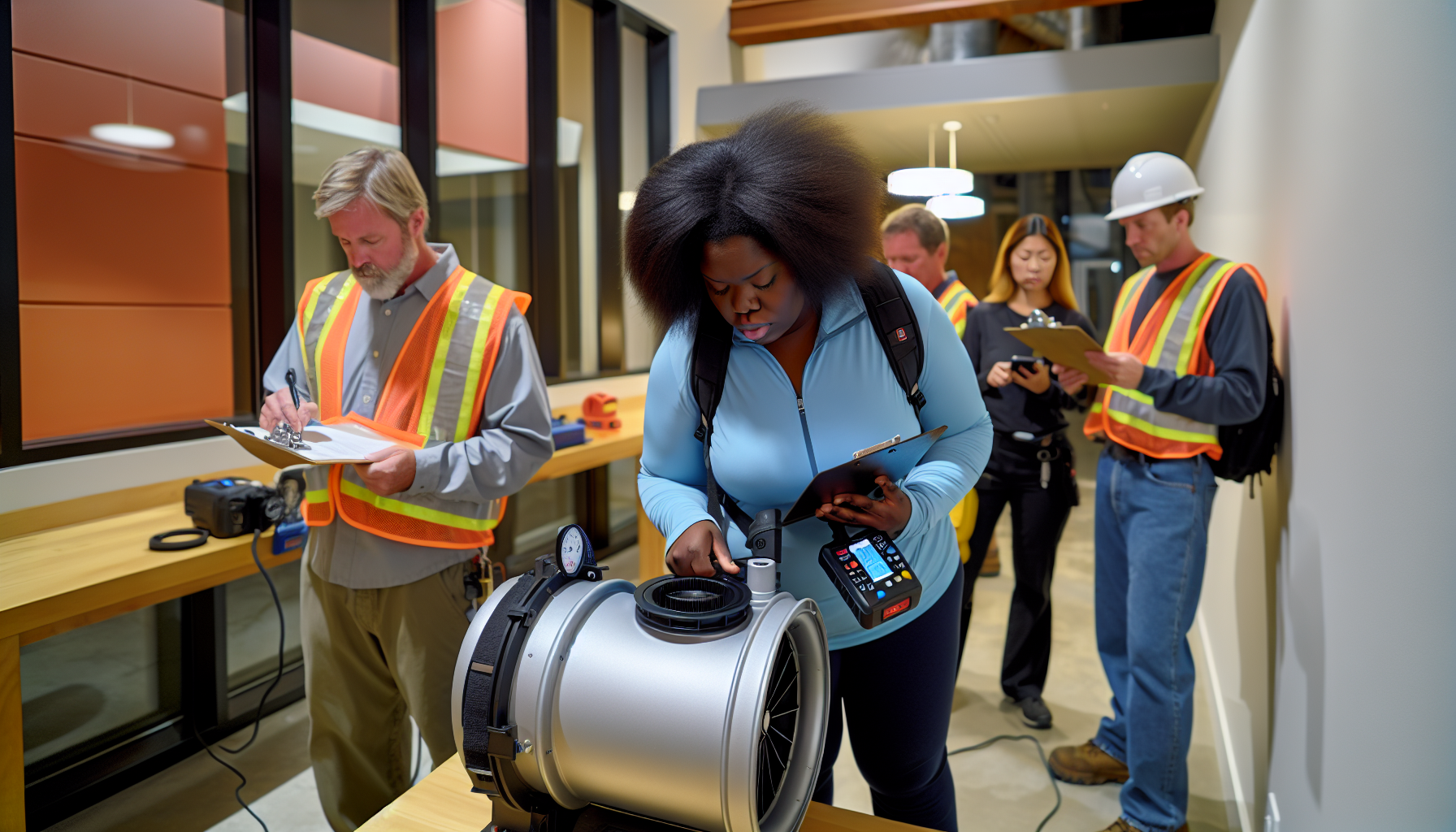Are you seeking precise air leakage assessments in buildings? Blower door test equipment is instrumental in this process, providing insights about airtightness critical for energy efficiency. In this article, you’ll discover how these systems work, what features differentiate the top models, and the practical considerations for choosing and using blower door test equipment in your energy audits.
Key Takeaways
- Blower door test equipment is crucial for assessing a building’s air tightness by measuring air leakage and flow, involving a door panel, a calibrated fan, and pressure gauges for precise measurement.
- The Minneapolis Blower Door Model 3 stands out in the market with features like the DG-1000 Pressure and Flow Gauge for accurate flow measurements and Cruise Control for consistent airtightness testing in varying weather conditions.
- Effective blower door tests hinge on proper building preparation, such as ensuring windows and doors are sealed and HVAC systems are off, and accurate interpretation of results based on air changes per hour at 50 pascals (ACH50) to determine the energy efficiency of the tested building.
Understanding Blower Door Test Equipment

Blower door test equipment revolutionizes energy efficiency by quantifying air leakage and measuring airflow between building zones, thereby reducing air leakage. At the heart of this equipment is an adjustable door panel, a variable speed fan with a speed controller, and a set of gauges, all designed according to testing procedures developed for accurate air leakage measurements.
However, the real strength of this equipment resides in its precision. Accurate flow measurements underpin blower door tests, assisting in estimating the total size of air leaks in a building and evaluating the building’s air tightness. The way this is achieved is through an intricate process involving a calibrated fan, creating a pressure differential between the interior and exterior of a building. This pressure variance enables the system to assess the volume of air leakage and pinpoint individual leaks in the building’s envelope.
How Blower Door Systems Work
Blower door system combines simplicity with sophistication, consisting of three main components: a calibrated fan, a door panel system, and a device to measure pressure. These systems are frequently used by HVAC contractors to assess the air tightness of a building and identify areas for improvement.
The door, equipped with a fan, creates a seal in the doorway, enabling the system to measure the pressure differentials inside and outside the building. The fan plays a critical role as it facilitates the movement of air for pressurizing or depressurizing a building during a building envelope test, ensuring accurate results in determining the air tightness of the building.
The methodology behind the measurement of air leakage involves:
- Establishing a pressure differential between the interior and exterior of a building
- Sustaining the pressure differential with a manometer or pressure gauge
- Quantifying the airflow passing through the fan
The Role of Accurate Flow Measurements
The accuracy of flow measurements in a blower door test is vital for guaranteeing dependable results. It allows for the correct identification of areas of leakage and the determination of the overall airtightness of the building, ultimately leading to reliable results. Inaccurate flow measurements, on the other hand, can result in misleading data, leading to incorrectly-sized mechanical systems and unreliable assessments of building airtightness.
To ensure that precise flow measurements are achieved, technologies that regulate and measure air pressure, air flow, and temperature are employed. The precision of flow measurement plays a critical role in obtaining accurate air leakage measurements using a blower door system, directly impacting the dependability of the blower door test and, consequently, the precise evaluation of a building’s air tightness.
Key Features of the Minneapolis Blower Door Model 3

The Minneapolis Blower Door Model 3 distinguishes itself among top-tier blower door models. This model is equipped with an AC 110 volt, 3/4 horsepower motor, a fan inlet diameter of 20 inches, and a length of 10.25 inches. It offers quick and precise flow measurements ranging from 300 to 6,100 CFM, with additional flow rings for extended measurement capabilities.
A standout feature of this model is the DG-1000 Pressure and Flow Gauge, a digital gauge specifically engineered to measure pressure and flow during blower door tests. This gauge works in conjunction with a single fan and incorporates Cruise Control for accurate and consistent flow measurements. Furthermore, the model’s Cruise Control feature enables more precise airtightness tests, even in challenging windy weather conditions.
DG-1000 Pressure and Flow Gauge
The DG-1000 Pressure and Flow Gauge is a standout feature in the Minneapolis Blower Door Model 3. It offers the following enhanced features:
- Extended battery life
- Improved Bluetooth connection
- Enhanced WiFi capabilities
- High-resolution display
- Dual channel pressure and flow measurements
With these specialized accessories, it sets the standard for blower door test gauges.
By providing consistent and accurate flow measurements, the DG-1000 enhances the Minneapolis Blower Door Model 3’s performance and removes the need for gauge dampening. It is integral in regulating the blower door system during tests, with functionalities such as the Cruise Control, which streamlines airflow adjustments.
Cruise Control Functionality
Cruise Control is another remarkable feature of the Minneapolis Blower Door Model 3. It serves to regulate the fan speed during automated testing or when utilizing TEC’s digital gauge cruise control function.
The Cruise Control function offers the following benefits:
- Significantly improves the precision and consistency of airtightness tests, particularly in adverse weather conditions
- Provides the capability to automatically control the Blower Door fan
- Maintains specific pressure levels as needed
While the Cruise Control feature may have limitations in windy conditions, its benefits far outweigh its limitations, making it an invaluable feature in blower door testing.
Comparison of Top Blower Doors on the Market

The marketplace offers a plethora of options for blower door systems. Among the top-rated systems are the Retrotec 6120 Hard Panel Blower Door System and the Minneapolis Blower Door™ by TEC. Each of these systems has unique features and capabilities that set them apart.
The Minneapolis Blower Door system by Energy Conservatory stands out due to its fan speed control placement, with a separate fan speed control, while Retrotec’s system integrates it into the fan itself. The Minneapolis Blower Door system is also compared to Infiltec’s Digital Blower Door system, another competitor in the industry.
Energy Conservatory vs. Competitors
The competition in the blower door systems industry is intense, with companies striving to increase quantity and quality of their products. Energy Conservatory, the creator of the Minneapolis Blower Door, faces stiff competition from brands like Retrotec, BlowerDoor GmbH, and Infiltec Inc.
The Energy Conservatory’s blower door system excels with its unique design features. It boasts a wood frame, Magnehelic gauges, and a Sharp calculator, contributing to improved accuracy in fan flow measurements. Despite the strong competition, user feedback for Energy Conservatory’s systems has been overwhelmingly positive, with users praising their reliability and efficiency.
Factors to Consider When Choosing a Blower Door System
Selecting the appropriate blower door system is key to obtaining precise and dependable outcomes. When procuring a blower door system, it is crucial to consider factors such as customization and versatility, measurement and calibration capabilities, and the system’s proficiency in identifying air leaks within a structure.
Cost also plays a significant role in the selection of a blower door system, as the average cost of a blower door test typically ranges from $200 to $450. This cost is influenced by factors such as location, size of the home, and complexity, read more about Understanding Blower Door Test Cost.
Lastly, one must not overlook the maintenance requirements for blower door systems. These requirements differ and are outlined in the manufacturer’s manual. Additionally, calibration and repair services are offered to uphold the systems’ accuracy over time.
Applications and Professionals Who Benefit from Blower Door Tests

Not only HVAC contractors and weatherization professionals but also others can benefit from blower door tests. They are also utilized by home builders and individuals pursuing high-performance certifications such as LEED. The primary purpose of blower door tests is to measure air leakage in buildings and assess the effectiveness of the air control layer or air barrier.
Moreover, blower door testing serves as a diagnostic tool utilized by home energy professionals to assess the air-tightness of a building and identify opportunities to improve energy efficiency. The steps involved in establishing airtightness testing procedures using blower door test equipment include:
- Preparing the home or building
- Setting up the blower door equipment according to the manufacturer’s instructions
- Conducting the blower door test
- Analyzing the results to determine the airtightness of the home or building.
Building Airtightness Testing Procedures
Building airtightness testing is a systematic process that requires careful preparation and execution. The established guidelines for performing a building airtightness test are outlined in the ‘Standard Method for Building Enclosure Airtightness Compliance Testing’. The essential procedures include thorough preparation of the building, meticulous execution of the test, and accurate documentation of the results.
Blower door tests play a crucial role in assessing the level of air leakage in a building’s enclosure, thus enabling the identification of air leakage sources and the provision of data on the building’s airtightness levels. This information is instrumental in making improvements to enhance energy efficiency and reduce air infiltration.
Utility DSM Programs and Energy Efficiency
Utility Demand Side Management (DSM) programs are activities carried out by electric utilities to manage and decrease quantity of electricity demand. These programs align with energy efficiency initiatives by integrating strategies to reduce consumption during peak times, shift usage to off-peak periods, and enhance overall system efficiency.
Blower door tests play a significant role as a diagnostic tool in utility DSM programs, allowing for the assessment of air leakage in homes and the identification of opportunities to improve energy efficiency. The results of a blower door test have a significant impact on the energy efficiency of a building as they provide specific measurements such as CFM50, which help in assessing the total air leakage and ultimately determining the energy performance of the building.
Tips for Conducting Effective Blower Door Tests

Following best practices is crucial to maximizing the effectiveness of your blower door tests. These include:
- Closing all windows
- Opening all interior doors
- Closing all exterior doors
- Turning off thermostats and air conditioners
- Inspecting for leaks
- Turning off any combustion appliances
It is also recommended to perform air-sealing while the blower door is running rather than conducting the test first for increased efficiency.
When it comes to interpreting blower door test results, it’s crucial to analyze the air changes per hour at 50 pascals (ACH50) measurement. Compliance with building codes necessitates new houses to maintain ACH50 values below 3 or 5, contingent on the location. Older homes should strive for even lower ACH50 values. It is crucial to factor in the climate and specific requirements when interpreting the results.
Preparing the Building
Appropriate preparation of the building is imperative for ensuring the accuracy of blower door test results. This includes:
- Closing all windows
- Opening all interior doors
- Closing all exterior doors
- Turning off thermostats, air conditioners, and other HVAC systems
- Inspecting the building for leaks
- Turning off all combustion appliances
In addition, sealing windows and doors is essential in preventing air leakage through these openings, thereby contributing to more precise measurements of air leakage throughout the entire building during a blower door test. It is also crucial to manage ventilation systems and combustion appliances during a blower door test, including turning off all fans and ensuring that air conditioners and HVAC fans are turned off.
Interpreting Test Results
Although interpreting blower door test results can be intricate, comprehending the results can yield valuable insights into a building’s energy efficiency. The standard procedure for interpreting blower door test results involves conducting the test at a pressure of 50 pascals and then correlating the blower door number with the home’s square footage.
The results of a blower door test have a significant impact on the energy efficiency of a building as they provide specific measurements such as CFM50, which help in assessing the total air leakage and ultimately determining the energy performance of the building. When interpreting blower door test results, it’s also important to be mindful of common errors, such as:
- Failing to consider the size of the home
- Disregarding weather conditions during testing
- Misinterpreting the calculations and metrics utilized in the test.
Summary
From understanding blower door test equipment to interpreting test results, we’ve journeyed through the intricate world of blower door testing. We’ve explored the significance of blower door tests in assessing a building’s airtightness, enhancing energy efficiency, and identifying opportunities for improvement. We’ve also delved into the key features of leading blower door systems, including the Minneapolis Blower Door Model 3, and provided practical tips for conducting effective blower door tests.
In conclusion, blower door tests are more than just a tool – they’re a game-changer in the realm of energy efficiency. Whether you’re an HVAC contractor, a weatherization professional, or a homeowner striving to improve your home’s energy efficiency, understanding and leveraging the power of blower door tests can make a significant difference. So, embrace the power of blower door tests, and step into an energy-efficient future.
Frequently Asked Questions
How much does blower door test equipment cost?
You can expect to spend between $5,000 and $6,000 on new blower door and duct testing equipment.
How to do your own blower door test?
To conduct your own blower door test, follow these steps: Confirm safety measures, create an airflow path, turn off gas appliances, mount the blower door, take an outdoor pressure reading, run the test using the fan, and inspect for leaks.
What is a good CFM for a blower door test?
A good CFM for a blower door test is generally less than 1,500 CFM at 50 pascals, while air flow above 4,000 CFM would be considered leaky. This valuable data can be obtained in about half an hour using a blower door.
Who performs a blower door test?
Professional energy assessors perform blower door tests to determine a home’s airtightness, which helps in assessing the amount of air entering or escaping from the home. Airtightness impacts infiltration and exfiltration of outdoor air through cracks and openings in the building.
What does a blower door test measure?
A blower door test measures the amount of air leakage through a building’s enclosure and the airflow between building zones, helping to decrease air leakage. It is an important step in ensuring energy efficiency and indoor air quality.
